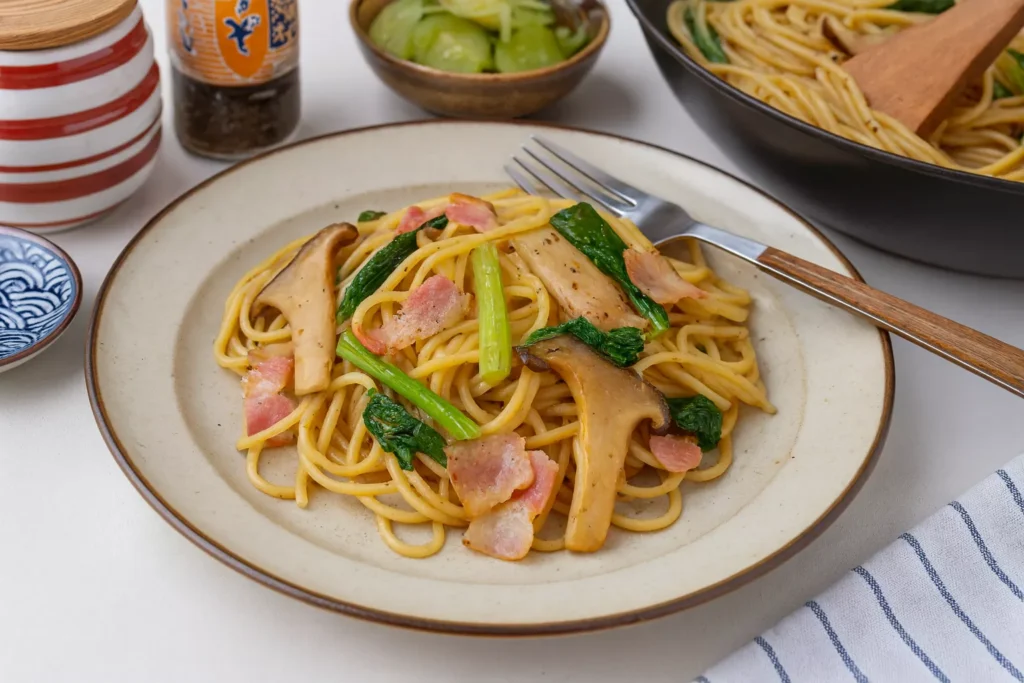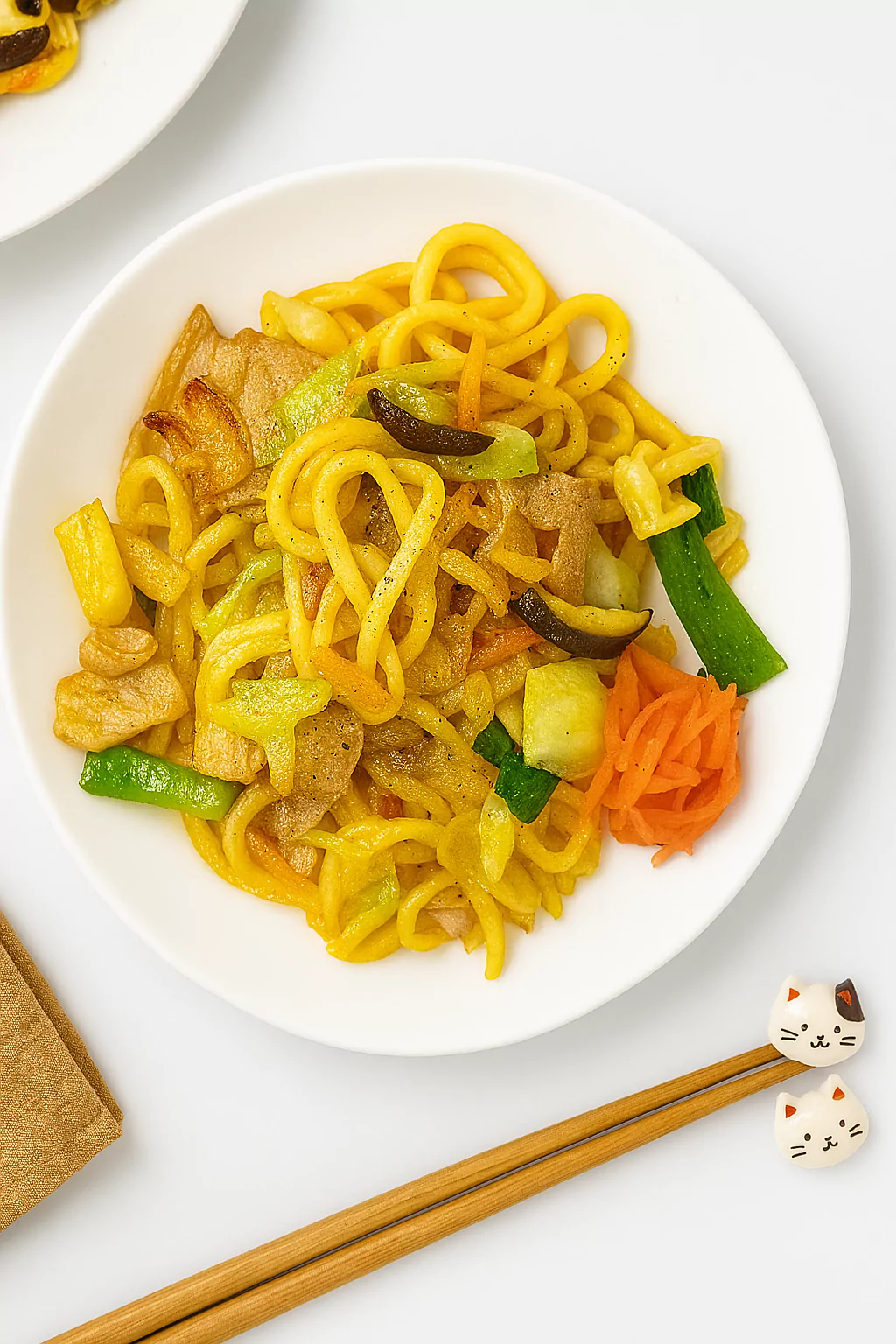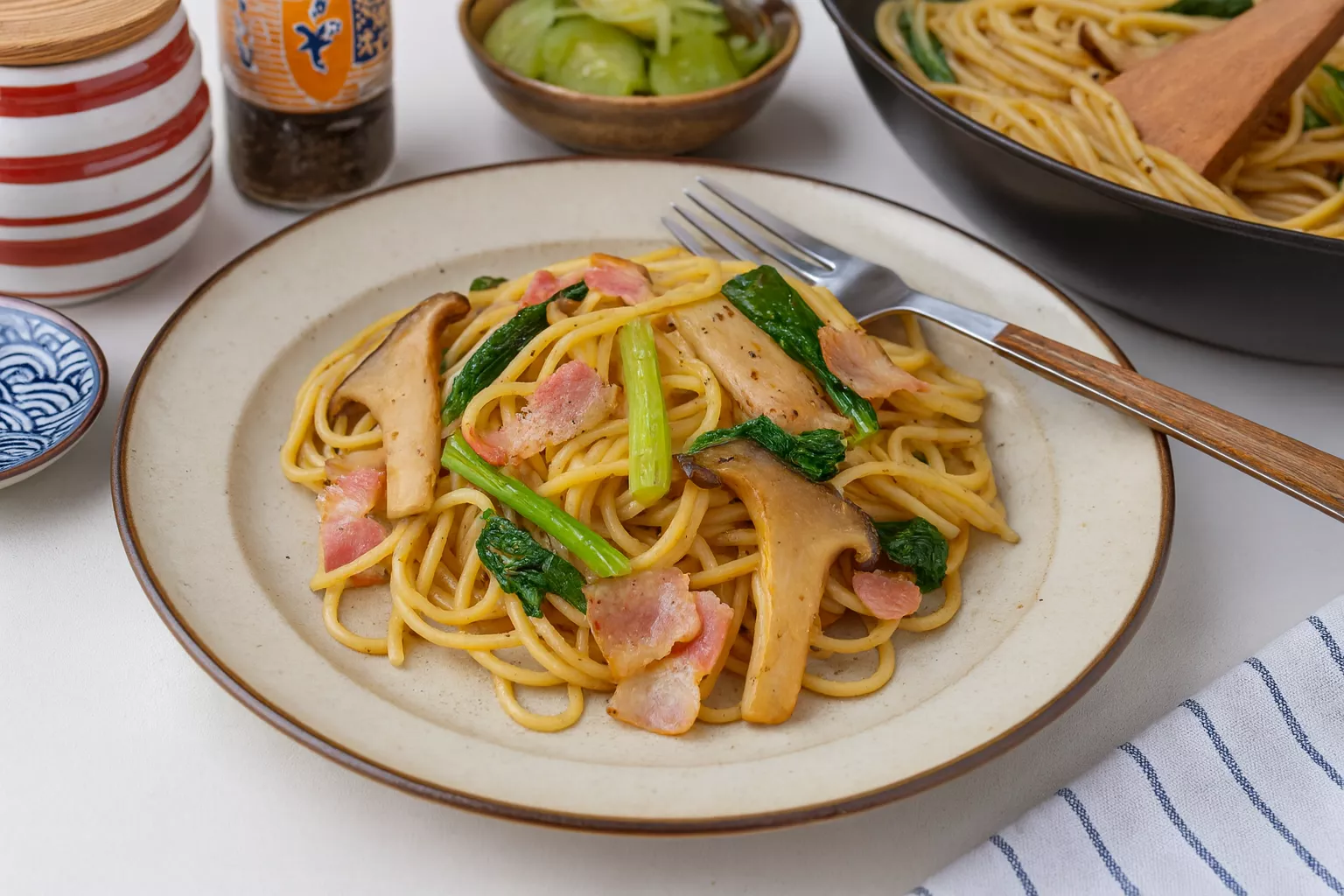Have you ever wondered what happens when Japanese flavors meet Italian pasta? Can a simple bowl of noodles capture the cozy comfort of home-cooked Japanese food while keeping the satisfying bite of classic spaghetti?
If that sounds intriguing, you’re about to discover something special — Japanese-style Pasta with Bacon and Mushrooms, known in Japan as ベーコンとキノコの和風パスタ (Bacon and Mushroom Wafu Pasta).
This dish combines the umami richness of soy sauce and dashi with the earthy taste of mushrooms and the gentle saltiness of bacon. It’s a recipe that turns an ordinary weekday meal into a quick, nourishing, and satisfying dinner that feels both elegant and easy.
Overview
Japanese-style pasta (和風パスタ or wafu pasta) is a modern fusion dish that takes the texture and technique of Italian pasta and infuses it with Japanese seasonings such as soy sauce, dashi, and sometimes miso or seaweed.
It’s light, flavorful, and usually quicker to make than cream- or tomato-based pasta dishes.
The Bacon and Mushroom version is especially popular because it blends the deep umami of mushrooms with the savory flavor of bacon — balanced perfectly by the delicate aroma of soy sauce and garlic. It’s comfort food with a Japanese soul.
- Time required: About 20–25 minutes
- Difficulty: Easy, beginner-friendly
- Servings: 1–2 people
This dish is perfect for anyone who loves pasta but wants something lighter and uniquely Japanese. You don’t need fancy ingredients — just a few simple pantry staples and fresh vegetables.
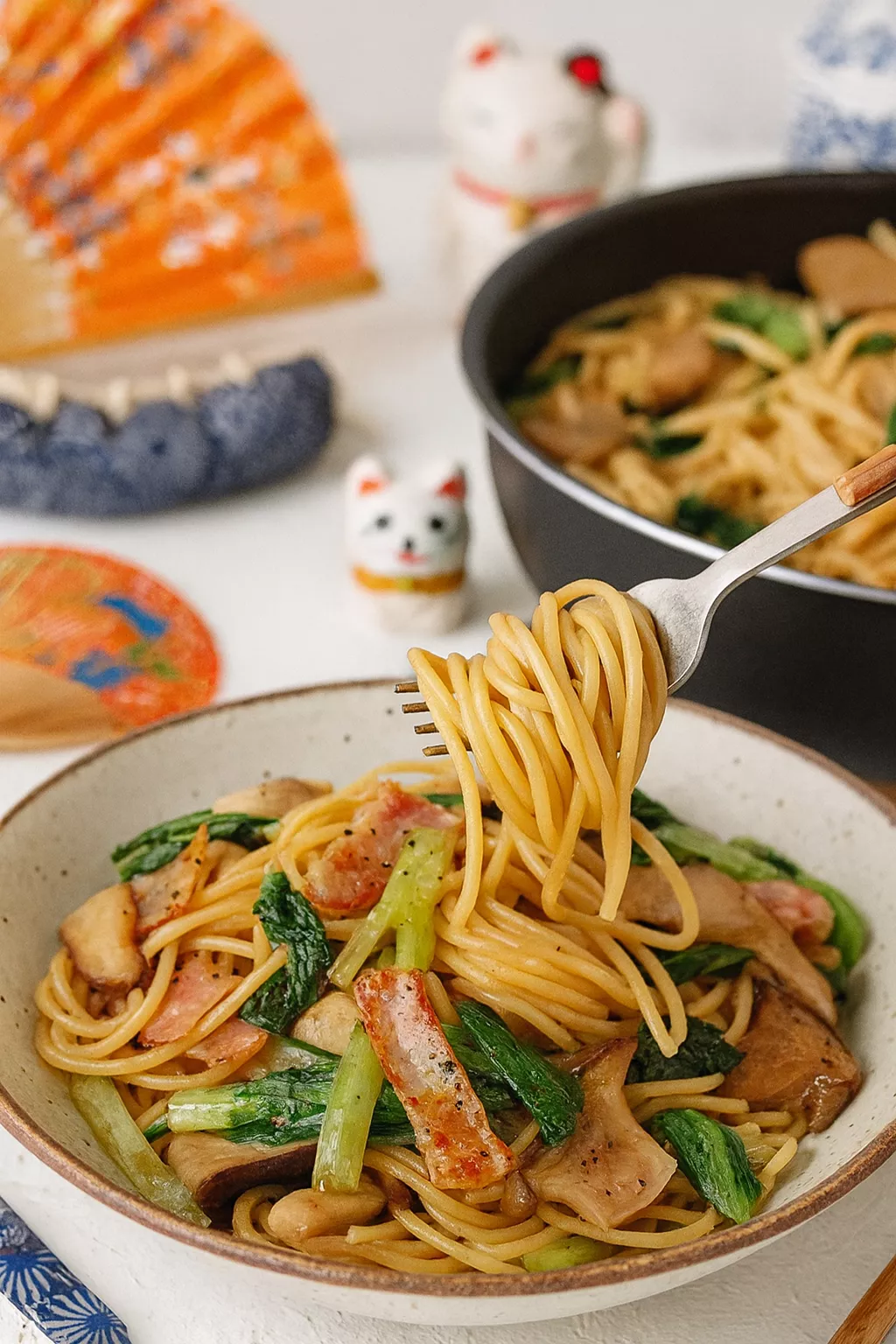
Japanese-style pasta @JapanDishes
What Is Japanese-style Pasta with Bacon and Mushrooms?
In Japan, wafu pasta is a common home-cooked meal and can be found in cafés and family restaurants. “Wafu” means “Japanese-style,” referring to dishes that adapt Western cooking to local tastes.
ベーコンとキノコの和風パスタ features sautéed king oyster mushrooms (or eringi), bacon, garlic, and soy sauce, giving the pasta a deep umami flavor and glossy texture. Unlike Western pasta, it skips heavy cream and butter, focusing instead on a clean, aromatic, and balanced taste.
The result? A deliciously simple noodle dish that feels light yet incredibly satisfying — perfect for lunch, dinner, or even a quick meal after a long day.
Jump to Recipe Print RecipeEssential Ingredients
Here’s what you need to make authentic Japanese-style Pasta with Bacon and Mushrooms at home:
Main Ingredients
- Komatsuna (Japanese mustard spinach) – 1/4 bag (about 50g)
Adds a mild bitterness and green freshness. If unavailable, substitute with spinach or bok choy. - King oyster mushrooms (eringi) – 1 bottle (about 100g)
Their meaty texture holds up well during sautéing. You can also use shiitake, shimeji, or enoki mushrooms for variety. - Bacon – 2 slices
Provides saltiness and umami richness. For a lighter option, try turkey bacon or smoked tofu. - Olive oil – 1 tablespoon
Used for frying and to carry the aroma of garlic and mushrooms. - Garlic paste (tube type) – 3 cm
Adds warmth and depth. Freshly minced garlic can also be used. - Pasta – 1 bunch (about 100g)
Spaghetti is most common, but linguine or angel hair also work well.
Seasoning Mix (A)
- Soy sauce – 2 teaspoons
The heart of Japanese-style flavor. Use a light soy sauce for a cleaner finish. - Granulated soup stock (dashi powder) – 1/2 teaspoon
Boosts umami, blending perfectly with mushrooms and bacon. - Coarsely ground black pepper – A little
For aroma and a hint of spice.
Why These Ingredients Matter
Each ingredient serves a purpose:
- Soy sauce and dashi bring Japanese depth.
- Mushrooms add earthy richness.
- Bacon and garlic give a western touch and aroma.
- Komatsuna adds freshness and color.
Substitutions and Variations:
- Use shiitake or maitake mushrooms if you can’t find king oyster.
- Replace komatsuna with spinach, kale, or chard.
- For a vegetarian version, use olive oil and mushrooms only, omitting bacon and adding tofu cubes or seaweed flakes.
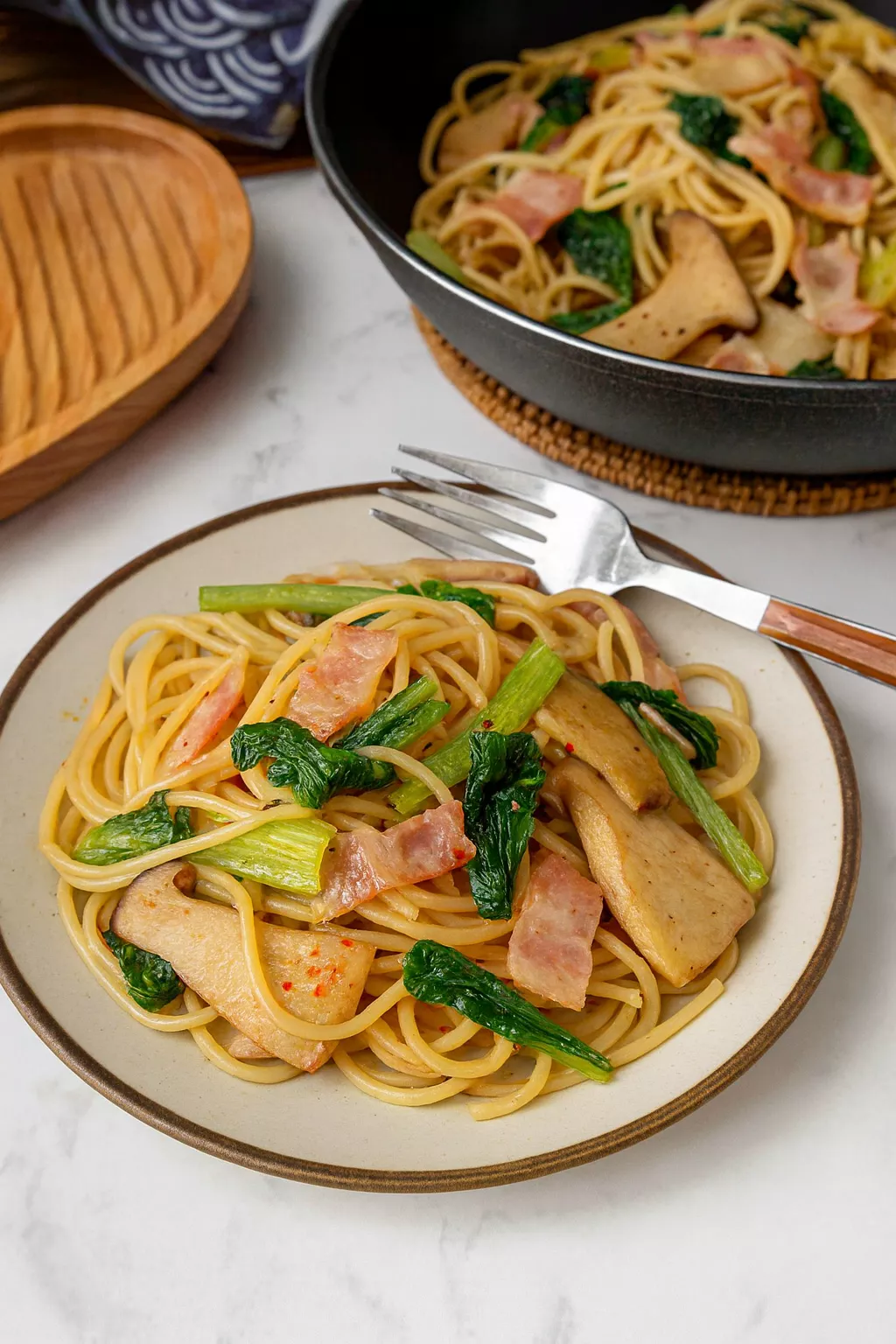
Step-by-Step Instructions
Follow these simple steps to create your Japanese-style pasta:
Step 1: Prepare the Ingredients
- Cut komatsuna into 3 cm-wide pieces.
Separate stems from leaves (stems cook longer). - Slice king oyster mushrooms into thirds lengthwise, then into thin slices.
- Cut bacon into 1 cm-wide strips.
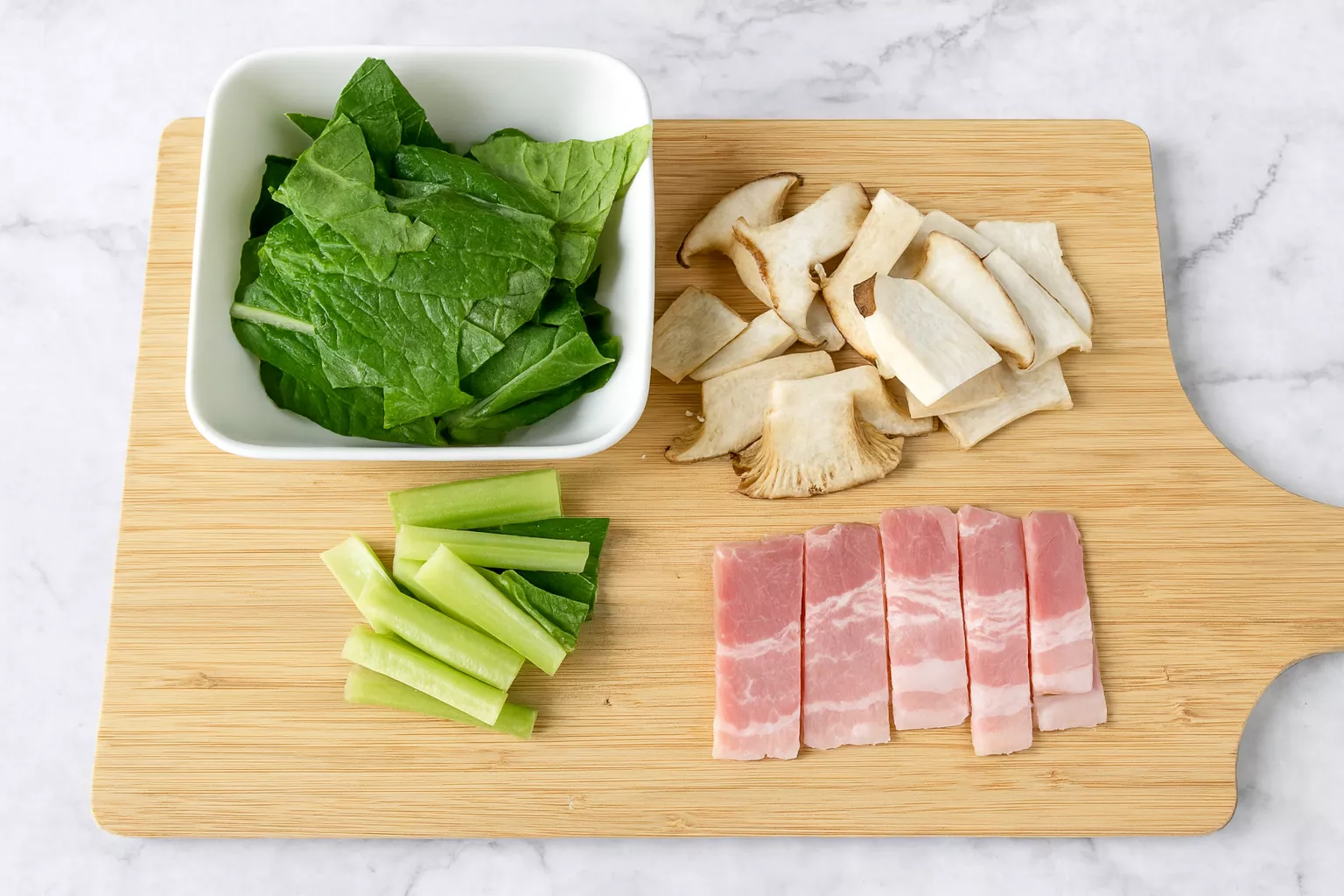
Organize everything before cooking; this recipe moves quickly once the heat is on.
Step 2: Stir-fry the Aromatics
- Heat 1 tablespoon olive oil in a frying pan over medium heat.
- Add komatsuna stems, mushrooms, bacon, and garlic paste.
- Stir-fry for about 2 minutes until the mushrooms soften and release aroma.
- Add komatsuna leaves and cook for another minute until wilted.
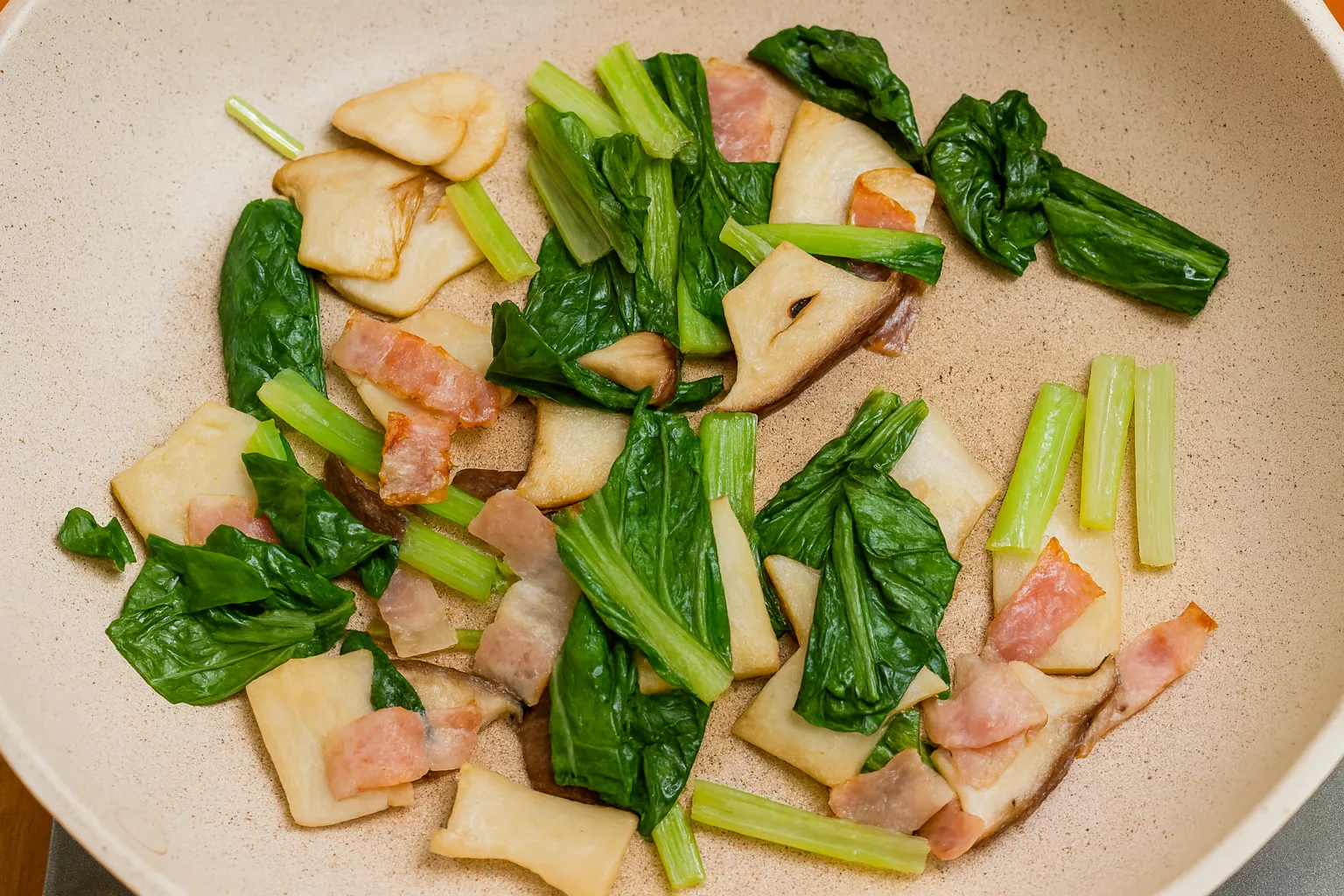
This creates the flavorful base for your pasta — rich with the smoky bacon scent and earthy mushrooms.
Step 3: Cook the Pasta
- Bring 1 liter of water to a boil in a pot.
- Add 1 teaspoon salt (not included in the main recipe).
- Boil the pasta according to package instructions.
- Before draining, reserve 80 ml of cooking water — it will help bind the sauce.
- Drain the pasta using a colander.
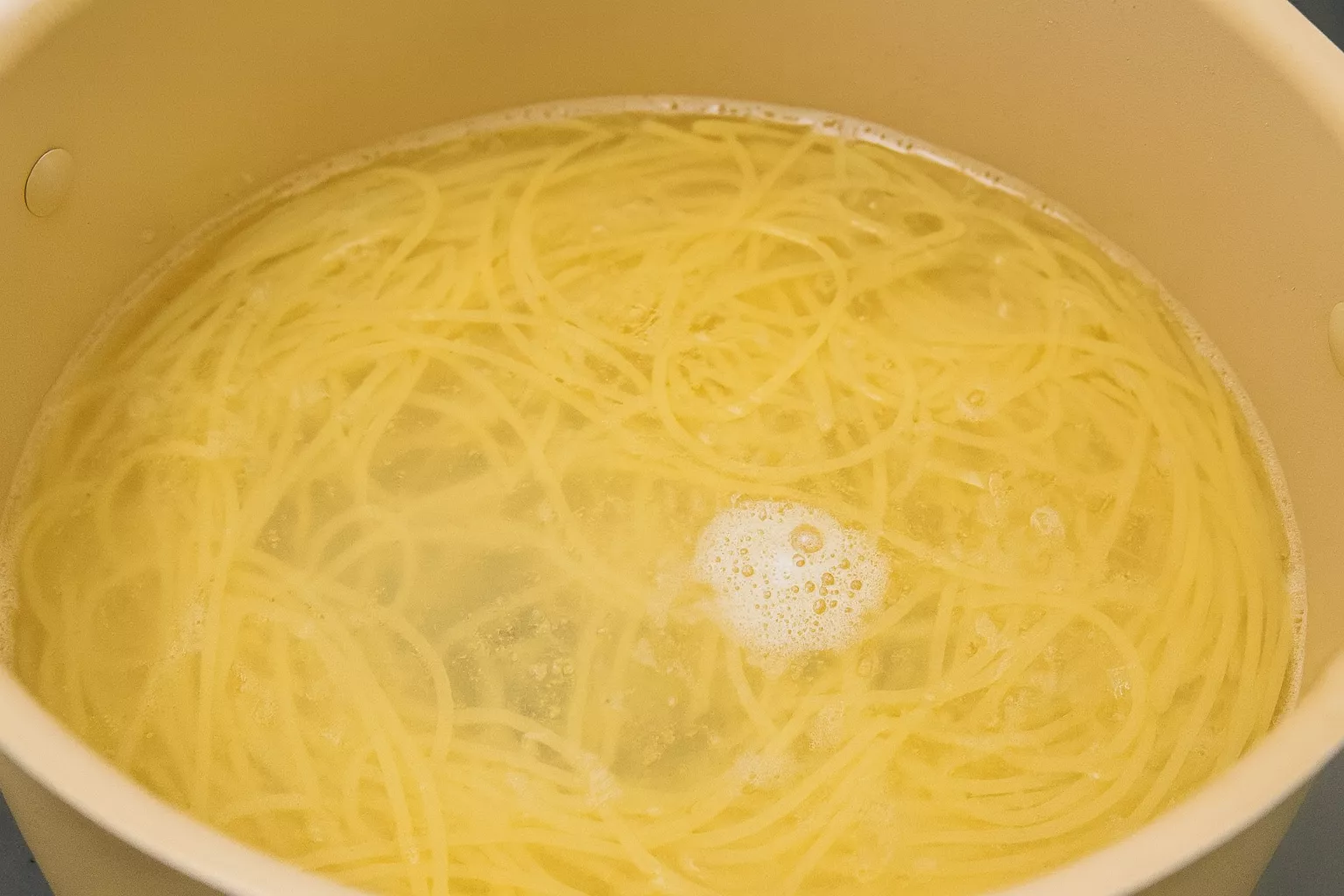
Step 4: Combine Everything
- Return the frying pan to medium heat.
- Add the cooked pasta, reserved cooking water (80 ml), soy sauce (2 tsp), and dashi powder (½ tsp).
- Toss quickly until all ingredients are coated and glossy.
- Let the sauce cling to the noodles for about 30 seconds.
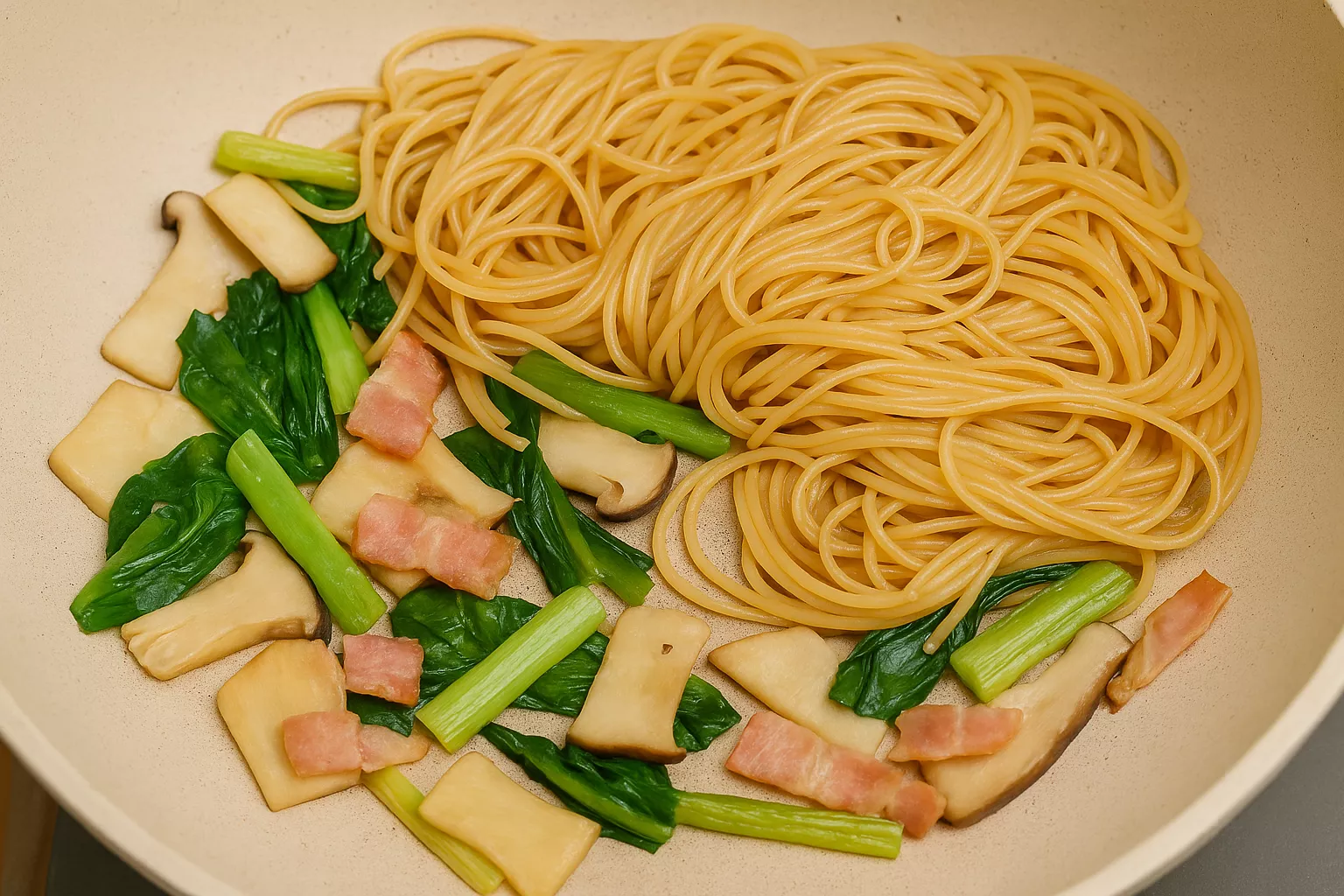
The soy sauce and dashi create a delicate glaze that perfectly wraps each strand of pasta.
Step 5: Serve and Garnish
Transfer the pasta to a bowl or Japanese-style plate.
Sprinkle coarsely ground black pepper on top.
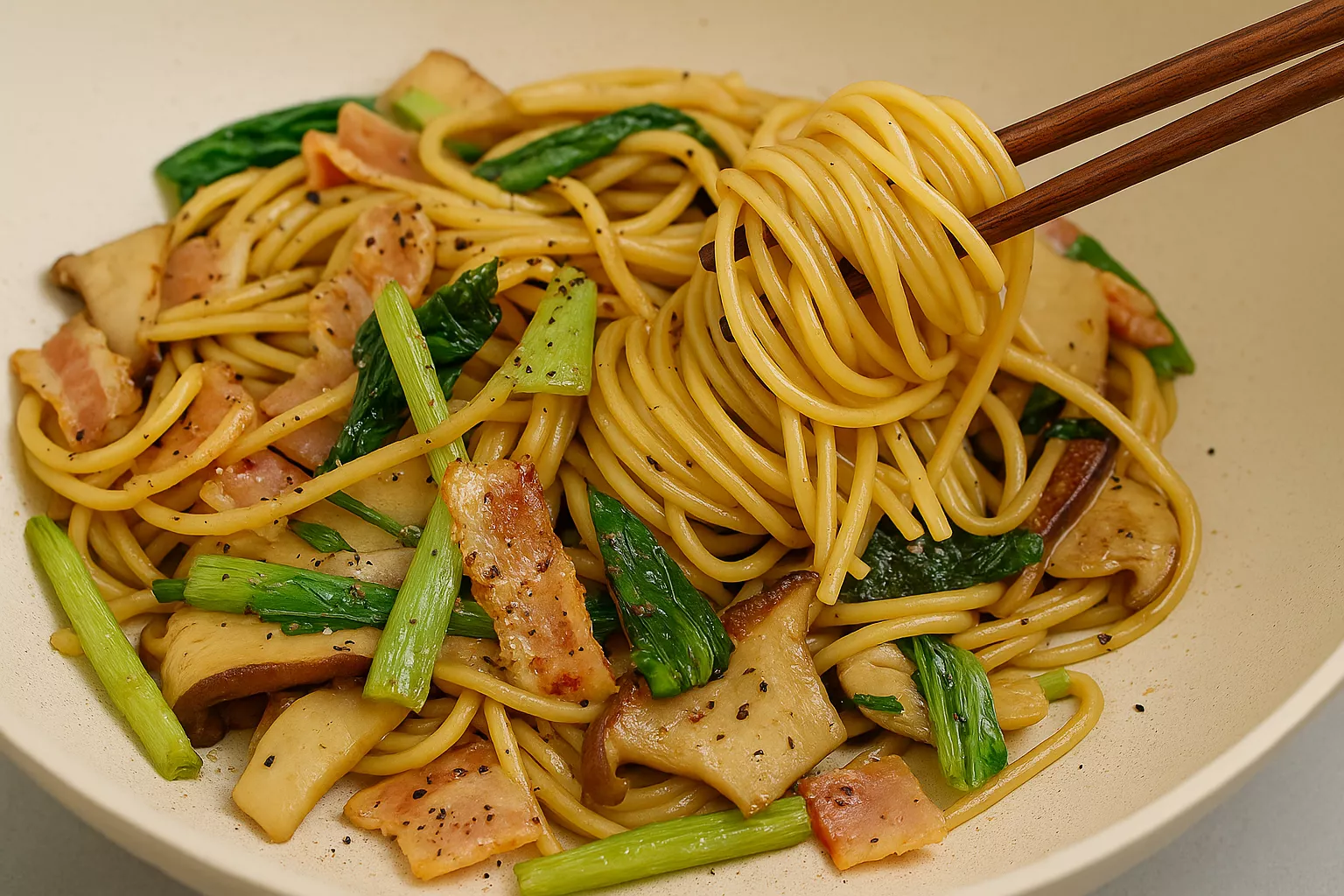
For an elegant presentation, arrange the mushrooms and bacon visibly on top, allowing the glossy noodles to peek through. The result looks beautiful and tastes comforting.
Secrets to Success and Expert Tips
- Don’t overcook the pasta. Keep it slightly firm (al dente) — it will continue to cook when mixed with the sauce.
- Use pasta water wisely. The starch in it helps emulsify the sauce, making it smooth and silky.
- Balance the flavors. Soy sauce provides saltiness, but bacon also adds salt — taste before adding more.
- Cook quickly. Japanese-style pasta relies on timing. Once the pasta is done, move fast to mix everything while it’s hot.
- Use fresh mushrooms. Their texture and aroma make a big difference. Avoid over-browning them — gentle sautéing is best.
- Try adding butter (optional). A small cube at the end adds depth and aroma for a richer flavor.
Expert tip: A touch of yuzu juice or lemon zest can brighten the flavor and make the dish feel lighter.
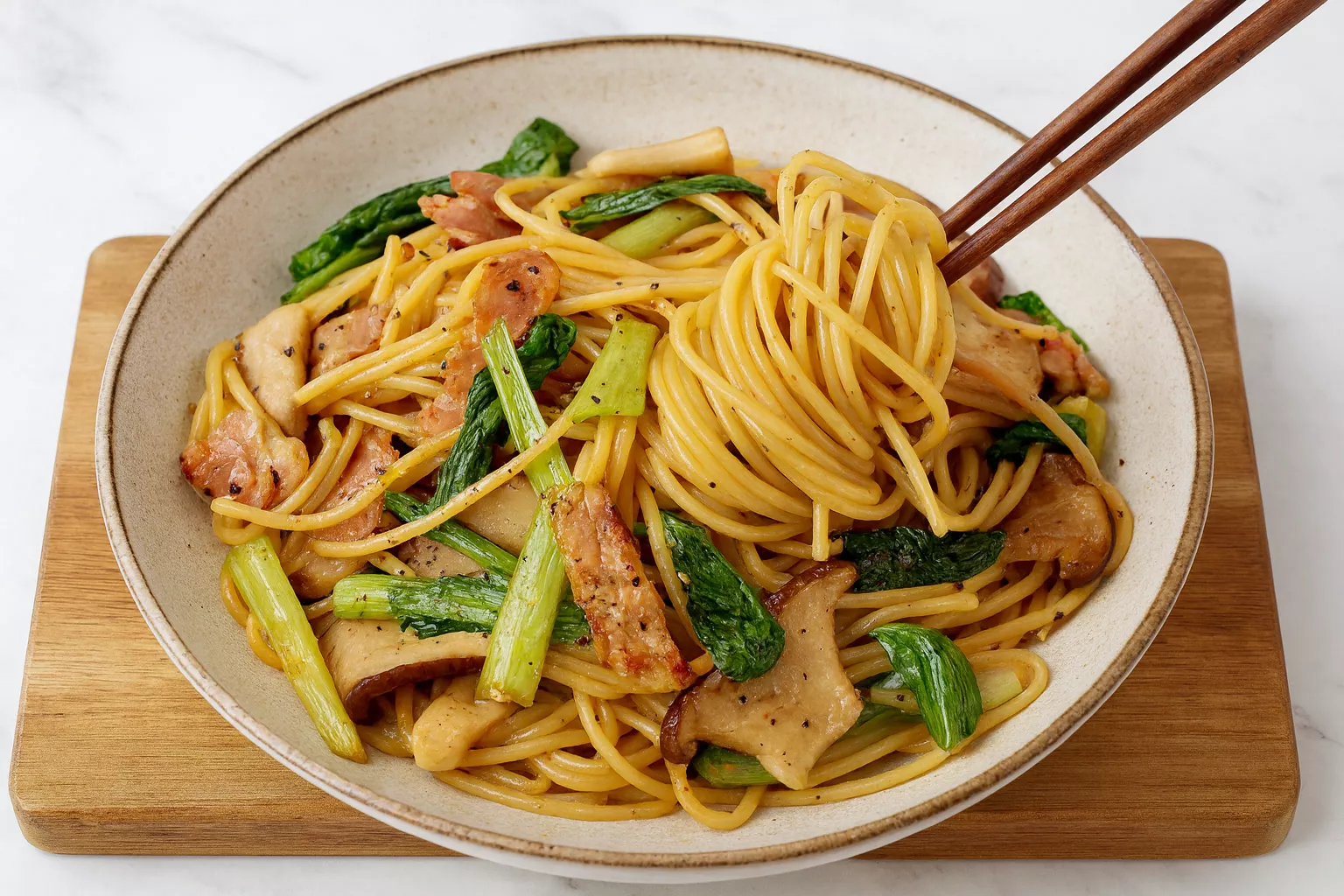
Assembly and Presentation
Building the perfect bowl of Japanese-style pasta is simple but rewarding. Start with a warm plate, twirl the pasta into a neat nest shape, and then layer the mushrooms and bacon on top.
Drizzle a few drops of olive oil or soy sauce around the plate rim for shine. If you like, sprinkle shredded nori (seaweed) or finely chopped green onions for a restaurant-style finish.
Hana’s Recipe Tips
Hana recommends slightly undercooking the noodles by one minute and finishing them in the sauce to let the flavors blend naturally. She also notes that king oyster mushrooms stay chewy and satisfying even after reheating, making this dish great for meal prep.
If you want to make the flavor deeper, sauté a few drops of mirin or butter at the end for a mellow finish.
Storage and Make-Ahead Tips
Japanese-style pasta tastes best fresh, but you can still enjoy leftovers.
- Refrigeration: Store in an airtight container for up to 2 days.
- Reheating: Sprinkle a tablespoon of water before microwaving for 1–2 minutes, or warm gently in a frying pan.
- Freezing: Not recommended — the texture of the pasta and vegetables changes after thawing.
For meal prep, you can pre-cut the ingredients (komatsuna, mushrooms, bacon) and store them separately. When you’re ready, just boil the pasta and sauté everything — dinner in under 15 minutes.
Recipe Variations
Want to personalize your dish? Try these easy twists:
- Spicy Wafu Pasta: Add chili flakes or a touch of wasabi for heat.
- Seafood Version: Replace bacon with shrimp or scallops for a coastal flavor.
- Vegetarian Version: Skip bacon, add tofu cubes or sesame seeds, and use soy-based dashi.
- Creamy Twist: Stir in a spoonful of soy milk or light cream for a fusion style.
- Yuzu or Ponzu Flavor: Replace soy sauce with ponzu for a citrusy aroma.
- Miso-Based Variation: Add a teaspoon of white miso for a deeper, nutty undertone.
Each version keeps the same comforting base while letting you explore new flavors.
Health Benefits
This Japanese-style pasta is more than just delicious — it’s also nutritious.
- Komatsuna provides calcium, iron, and vitamin C.
- Mushrooms are rich in antioxidants and low in calories.
- Olive oil supports heart health.
- Garlic boosts immunity.
Because the recipe uses less oil and no heavy cream, it’s lighter than Western pasta yet still full of flavor.
You Might Also Like These Japanese Noodle Recipes
If you enjoyed making this Japanese-style Pasta with Mushroom Noodles (ベーコンとキノコの和風パスタ), you’ll love exploring more delicious noodle dishes on JapanDishes.
Try the rich and creamy Creamy Japanese Mentaiko Pasta (明太子パスタ) for a spicy cod roe twist, or the savory Yaki Udon (Stir-Fried Udon Noodles) 焼きうどん packed with vegetables and umami flavor. Both are quick, comforting, and showcase the best of Japanese-style noodles.
Conclusion
Japanese-style Pasta with Bacon and Mushrooms (ベーコンとキノコの和風パスタ) proves that simple ingredients can create extraordinary flavors. With just a few pantry staples and about 20 minutes, you can bring the comforting taste of Japan right to your kitchen table.
Whether you’re cooking for yourself or sharing with loved ones, this dish offers the perfect balance of umami, aroma, and warmth.
So next time you crave pasta, skip the tomato sauce — try this Japanese-style twist instead. You’ll fall in love with the delicate harmony of mushrooms, bacon, and soy-scented noodles.
f you’re inspired by the flavors of Japan, why not explore its stunning winter scenery too? Discover the beauty of snowy landscapes, hot springs, and cozy food experiences in Japan’s coldest months through our detailed travel guide Snow in Japan: 7 Best Cities for Stunning Winter Views.
FAQs
Q1: What makes Japanese-style pasta different from Italian pasta?
Japanese-style pasta replaces tomato or cream sauces with soy sauce, dashi, and other Japanese condiments. The flavors are lighter and emphasize umami rather than richness.
Q2: Can I use other types of mushrooms?
Yes! Shiitake, shimeji, or enoki mushrooms are all great alternatives. Each brings its own unique texture and aroma.
Q3: How can I make this dish vegetarian?
Simply skip the bacon and use soy-based dashi or mushroom broth for umami.
Q4: Is this recipe suitable for meal prep?
Yes. Store cooked pasta and sauce together for up to 2 days in the fridge. Reheat gently before serving.
Q5: Can I add cheese?
Although not traditional, adding a small sprinkle of Parmesan can create an interesting Japanese-Italian fusion.
Q6: What is the best pasta type for this dish?
Spaghetti or linguine works best, but you can also use soba or udon for a more Japanese touch.
Final Thought
Japanese-style Pasta with Bacon and Mushrooms combines the simplicity of home cooking with the elegance of fusion cuisine. It’s proof that food doesn’t need to be complicated to be delicious — sometimes, it just needs the right balance of flavors.
Enjoy your homemade Mushroom Noodles — and don’t forget to experiment with your favorite Japanese ingredients next time!
Japanese-style Pasta: How to Cook Mushroom Noodles at Home
Course: MainCuisine: JapaneseDifficulty: Easy2
servings10
minutes15
minutes480
kcalThis easy Japanese-style pasta combines smoky bacon, earthy mushrooms, and fresh komatsuna greens tossed in a savory soy sauce base. A perfect weeknight fusion meal ready in under 25 minutes.
Ingredients
1/4 bag (50 g) komatsuna (Japanese mustard spinach)
1 bottle (100 g) king oyster mushrooms (eringi)
2 slices bacon
1 tablespoon olive oil
3 cm garlic paste (or 1 clove minced garlic)
1 bunch (100 g) spaghetti or preferred pasta
- Seasoning
2 teaspoons soy sauce
1/2 teaspoon granulated dashi soup stock
A pinch of coarsely ground black pepper
- Optional Garnish:
Shredded nori (seaweed)
Chopped green onions
Directions
- Step 1:
Cut komatsuna into 3 cm pieces, separating stems from leaves. Slice mushrooms lengthwise into thin strips. Cut bacon into 1 cm slices. - Step 2:
Heat olive oil in a frying pan over medium heat. Add garlic paste, bacon, mushrooms, and komatsuna stems. Sauté for about 2 minutes until fragrant. - Step 3:
Add komatsuna leaves and cook for 1 more minute, stirring until lightly wilted. - Step 4:
Boil 1 liter of water with 1 teaspoon salt. Cook pasta according to package instructions. Reserve 80 ml of pasta water before draining. - Step 5:
Add cooked pasta to the frying pan. Pour in the reserved pasta water, soy sauce, and dashi powder. Toss quickly over medium heat for 30 seconds until glossy. - Step 6:
Serve immediately. Sprinkle with black pepper and optional toppings like nori or green onions.
Notes
- ✪ Hana’s Tip: Slightly undercook the pasta by one minute and finish cooking it in the sauce — this helps it absorb the flavors better.
✪ You can substitute komatsuna with spinach or bok choy if unavailable.
✪ For a richer flavor, stir in a small knob of butter before serving.
✪ Keep leftovers in an airtight container for up to 2 days in the fridge. Add a spoon of water when reheating.
